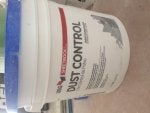I just had drywall installed on the entire main floor of my house that was previously 3/4" T&G knotty pine. The home was built in 1992 and all walls, interior and exterior, are 2x6 16"OC and floor joists for both 1st and 2nd story are 2x12 lumber 16"OC.
My contractor used lightweight "anti-sag" USG 1/2" drywall on walls and ceiling, fiberglass mesh tape (FibaTape brand), and USG Dust Control joint compound for all tape/mud coats (including setting the fiberglass tape).
The sanding of the drywall had been complete for approximately two days (climate controlled house ~68ºF) before they primed all the walls and ceilings. After they primed, I noticed hairline cracks in nearly every drywall seam. Quite honestly, you could make out the size of the drywall sheet, be it 4x8, 4x12, etc. based on the perimeter cracks at the seams. After pointing it out to my contractor, he skimmed over the cracks and re-primed the walls and ceiling. Almost as the primer was drying, nearly 50% of the cracks returned and a few more since then which was two days ago.
My first thought in regard to the cause of the cracks was movement, but please see the attached photo of an example of one of the cracks. This is a crack at a butt seam over a 3-ply 12" LVL. I could see cracks happening if the house was moving/settling, but even if the house fell in to a sink hole, I would expect the drywall seams to remian in-tact and crack free over a 12" LVL. I also have cracks at two other seams that are butted up over a 3-ply 2x12 header... again, no movement should be happening here. Additionally, I drywalled two of the rooms in the house several years ago and have no cracks, but the new drywall my contractor installed on the opposite side of the wall that I drywalled has cracks.
I'm not sure how to proceed. I believe the cause of the cracks is a combination of mesh tape and lightweight premixed joint compound. I spoke with my contractor this morning and he said they could go over my seams with "SuperTape," a product I've never heard of and couldn't find any info about online, but is supposedly a plastic joint tape with adhesive paper edges. My opinion of this product is that I'm going to have essentially thicker than butt-joint build up on all my seams with this product, especially because they'll be applying it over the top of already taped and feathered seams and butt joints. Additionally, I think the cracks will probably just return at the edges of the plastic that's bridging the seams instead of where they currently are in the center of the seam.
What do you guys think?
Is there any real alternative to cutting out the original tape and setting mud and/or replacing the drywall all together and then taping/mudding with the proper products?
My contractor used lightweight "anti-sag" USG 1/2" drywall on walls and ceiling, fiberglass mesh tape (FibaTape brand), and USG Dust Control joint compound for all tape/mud coats (including setting the fiberglass tape).
The sanding of the drywall had been complete for approximately two days (climate controlled house ~68ºF) before they primed all the walls and ceilings. After they primed, I noticed hairline cracks in nearly every drywall seam. Quite honestly, you could make out the size of the drywall sheet, be it 4x8, 4x12, etc. based on the perimeter cracks at the seams. After pointing it out to my contractor, he skimmed over the cracks and re-primed the walls and ceiling. Almost as the primer was drying, nearly 50% of the cracks returned and a few more since then which was two days ago.
My first thought in regard to the cause of the cracks was movement, but please see the attached photo of an example of one of the cracks. This is a crack at a butt seam over a 3-ply 12" LVL. I could see cracks happening if the house was moving/settling, but even if the house fell in to a sink hole, I would expect the drywall seams to remian in-tact and crack free over a 12" LVL. I also have cracks at two other seams that are butted up over a 3-ply 2x12 header... again, no movement should be happening here. Additionally, I drywalled two of the rooms in the house several years ago and have no cracks, but the new drywall my contractor installed on the opposite side of the wall that I drywalled has cracks.
I'm not sure how to proceed. I believe the cause of the cracks is a combination of mesh tape and lightweight premixed joint compound. I spoke with my contractor this morning and he said they could go over my seams with "SuperTape," a product I've never heard of and couldn't find any info about online, but is supposedly a plastic joint tape with adhesive paper edges. My opinion of this product is that I'm going to have essentially thicker than butt-joint build up on all my seams with this product, especially because they'll be applying it over the top of already taped and feathered seams and butt joints. Additionally, I think the cracks will probably just return at the edges of the plastic that's bridging the seams instead of where they currently are in the center of the seam.
What do you guys think?
Is there any real alternative to cutting out the original tape and setting mud and/or replacing the drywall all together and then taping/mudding with the proper products?







